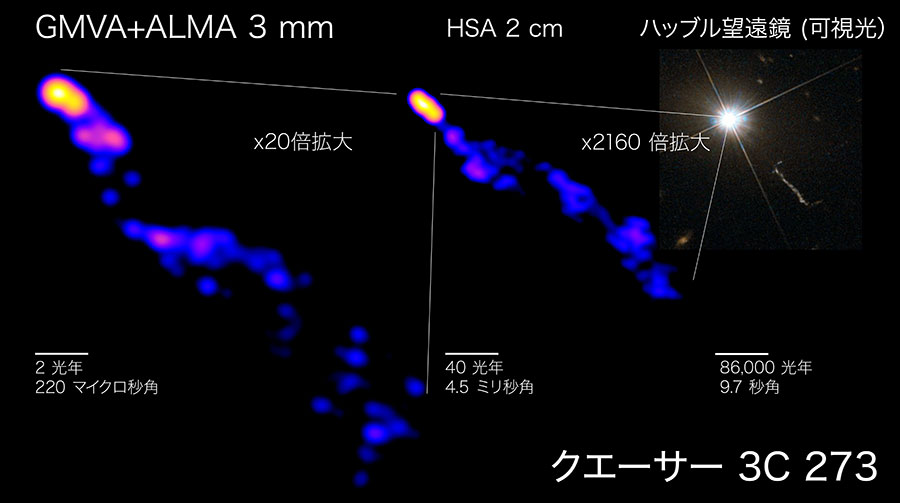- 短距離ガンマ線バーストホストの最も確実なカタログを作成
Astronomers produce the most robust catalog to date of short gamma-ray burst hosts
- 短いGRBホスト銀河。I. 光度・分光カタログ、ホスト銀河、銀河系オフセット Short GRB Host Galaxies. I. Photometric and Spectroscopic Catalogs, Host Associations, and Galactocentric Offsets
- 短いGRBホスト銀河。II. 赤方偏移、恒星集団の性質、中性子星合体の起源に関するレガシーサンプル Short GRB Host Galaxies. II. A Legacy Sample of Redshifts, Stellar Population Properties, and Implications for Their Neutron Star Merger Origins
短距離ガンマ線バーストホストの最も確実なカタログを作成 Astronomers produce the most robust catalog to date of short gamma-ray burst hosts
2022-11-21 ペンシルベニア州立大学(PennState)
研究チームは、W.M.ケック天文台、ラスカンパナス天文台、MMT天文台、ジェミニ天文台にあるいくつかの高感度機器からの情報と、これまでこの分野で使われた中で最も高度な銀河モデルを使って、これらのsGRBを発生させた天体を同定した。
sGRBは、2つの中性子星が衝突したときに放出される、強烈なガンマ線の瞬間的な閃光である。研究チームは、SGRBが宇宙で最も明るい爆発であることにちなんで、このカタログをBRIGHT (Broadband Repository for Investigating Gamma-ray Burst Host Traits) と呼び、すべてのデータとモデリングデータをオンラインで公開し、コミュニティで利用できるようにしている。
この研究の最初の論文では、sGRBがこれまで考えられていたよりも宇宙の早い時期に、そしてホスト銀河の中心からより遠い場所で発生していることがわかりました。また、これらの爆発のいくつかは、まるで「追い出された」かのように、ホスト銀河のすぐ外側で発見され、どのようにしてそこまで移動することができたのか、という疑問が生じました。
同じ雑誌に掲載された2つ目の研究論文は、sGRB のホスト銀河のうち 69 個の特徴を探ったものです。その結果、約 85% が若く活発な星生成銀河であることがわかりました。
中性子星がどのように合体し、どれくらいの時間をかけて合体するのかについては、まだ多くの疑問が残っている。しかし、sGRBとそのホスト銀河の観測は、それらに答えるための最良の視点のひとつであり、現在の重力波検出器よりもはるかに遠くで、より頻繁に中性子星の合体やそのホストに関するデータを提供することができる。したがって、この新しいsGRBホストカタログは、宇宙時間の中でこれらのシステムの完全な進化を理解するための、今後10年間の重要な参考資料となることだろう。
<関連情報>
- https://www.psu.edu/news/eberly-college-science/story/tracing-origins-rare-cosmic-explosions/
- https://iopscience.iop.org/article/10.3847/1538-4357/ac91d0
- https://iopscience.iop.org/article/10.3847/1538-4357/ac91d1
短いGRBホスト銀河。I. 光度・分光カタログ、ホスト銀河、銀河系オフセット Short GRB Host Galaxies. I. Photometric and Spectroscopic Catalogs, Host Associations, and Galactocentric Offsets
Wen-fai Fong, Anya E. Nugent, Yuxin Dong, Edo Berger, Kerry Paterson, Ryan Chornock, Andrew Levan, Peter Blanchard, Kate D. Alexander, Jennifer Andrews, Bethany E. Cobb, Antonino Cucchiara, Derek Fox, Chris L. Fryer, Alexa C. Gordon, Charles D. Kilpatrick, Ragnhild Lunnan, Raffaella Margutti, Adam Miller, Peter Milne, Matt Nicholl, Daniel Perley, Jillian Rastinejad, Alicia Rouco Escorial, Genevieve Schroeder, Nathan Smith, Nial Tanvir and Giacomo Terreran
The Astrophysical Journal Published 2022 November 21
DOI :10.3847/1538-4357/ac91d0

Abstract
We present a comprehensive optical and near-infrared census of the fields of 90 short gamma-ray bursts (GRBs) discovered in 2005–2021, constituting all short GRBs for which host galaxy associations are feasible (≈60% of the total Swift short GRB population). We contribute 274 new multi-band imaging observations across 58 distinct GRBs and 26 spectra of their host galaxies. Supplemented by literature and archival survey data, the catalog contains 542 photometric and 42 spectroscopic data sets. The photometric catalog reaches 3σ depths of ≳24–27 mag and ≳23–26 mag for the optical and near-infrared bands, respectively. We identify host galaxies for 84 bursts, in which the most robust associations make up 56% (50/90) of events, while only a small fraction, 6.7%, have inconclusive host associations. Based on new spectroscopy, we determine 18 host spectroscopic redshifts with a range of z ≈ 0.15–1.5 and find that ≈23%–41% of Swift short GRBs originate from z > 1. We also present the galactocentric offset catalog for 84 short GRBs. Taking into account the large range of individual measurement uncertainties, we find a median of projected offset of ≈7.7 kpc, for which the bursts with the most robust associations have a smaller median of ≈4.8 kpc. Our catalog captures more high-redshift and low-luminosity hosts, and more highly offset bursts than previously found, thereby diversifying the population of known short GRB hosts and properties. In terms of locations and host luminosities, the populations of short GRBs with and without detectable extended emission are statistically indistinguishable. This suggests that they arise from the same progenitors, or from multiple progenitors, which form and evolve in similar environments. All of the data products are available on the Broadband Repository for Investigating Gamma-Ray Burst Host Traits website.
短いGRBホスト銀河。II. 赤方偏移、恒星集団の性質、中性子星合体の起源に関するレガシーサンプル Short GRB Host Galaxies. II. A Legacy Sample of Redshifts, Stellar Population Properties, and Implications for Their Neutron Star Merger Origins
Anya E. Nugent, Wen-Fai Fong, Yuxin Dong (董雨欣), Joel Leja, Edo Berger, Michael Zevin, Ryan Chornock, Bethany E. Cobb, Luke Zoltan Kelley, Charles D. Kilpatrick, Andrew Levan, Raffaella Margutt, Kerry Paterson, Daniel Perley, Alicia Rouco Escorial, Nathan Smith, and Nial Tanvir
The Astrophysical Journal Published 2022 November 21
DOI: 10.3847/1538-4357/ac91d1

Abstract
We present the stellar population properties of 69 short gamma-ray burst (GRB) host galaxies, representing the largest uniformly modeled sample to date. Using the Prospector stellar population inference code, we jointly fit photometry and/or spectroscopy of each host galaxy. We find a population median redshift of (68% confidence), including nine photometric redshifts at z ≳ 1. We further find a median mass-weighted age of tm = Gyr, stellar mass of log(M*/M⊙) = , star formation rate of SFR = M⊙ yr−1, stellar metallicity of log(Z*/Z⊙) = , and dust attenuation of mag (68% confidence). Overall, the majority of short GRB hosts are star-forming (≈84%), with small fractions that are either transitioning (≈6%) or quiescent (≈10%); however, we observe a much larger fraction (≈40%) of quiescent and transitioning hosts at z ≲ 0.25, commensurate with galaxy evolution. We find that short GRB hosts populate the star-forming main sequence of normal field galaxies, but do not include as many high-mass galaxies as the general galaxy population, implying that their binary neutron star (BNS) merger progenitors are dependent on a combination of host star formation and stellar mass. The distribution of ages and redshifts implies a broad delay-time distribution, with a fast-merging channel at z > 1 and a decreased neutron star binary formation efficiency from high to low redshifts. If short GRB hosts are representative of BNS merger hosts within the horizon of current gravitational wave detectors, these results can inform future searches for electromagnetic counterparts. All of the data and modeling products are available on the Broadband Repository for Investigating Gamma-ray burst Host Traits website.



